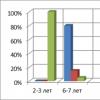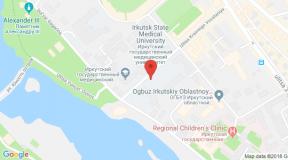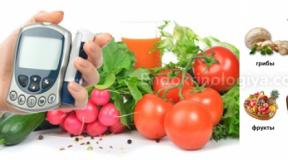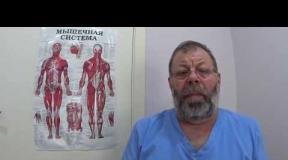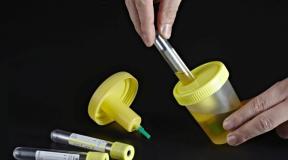Preparations for parenteral nutrition, indications for it, complications. Pvbepiezp postoperative management of patients. enteral, parenteral and enteral tube feeding. the procedure for examining patients on parenteral nutrition Vitamins and mi
In modern medicine, artificial nutrition is one of the main types of treatment in a hospital setting. It is used in various fields of medicine. With certain diseases, it is not enough for the patient to receive natural nutrition (through the mouth) or, for certain reasons, it is impossible. In this case, additional or basic artificial nutrition is used.
Introduce it different ways... Most often, this is practiced during surgical interventions in patients with nephrological, gastroenterological, oncological and geriatric diseases. What types of artificial nutrition are practiced in modern medicine, as well as the features of enteral and parenteral nutrition, will be discussed in this article.
Who needs nutritional support
Enteral and parenteral nutrition is aimed at providing nutritional support, that is, a complex treatment measures, the purpose of which is to determine and correct violations of the nutritional status of the body.
With timely provision of nutritional support, it is possible to significantly reduce the number and frequency of infectious complications and deaths, as well as stimulate the rehabilitation of patients.
Nutritional support can be either complete, when the main or all of a person's need for nutrition is provided artificially, or partial, when such nutrition is in addition to the usual one.
There are many indications for artificial nutrition. To summarize, we are talking about any diseases for which adequate natural nutrition is impossible. As a rule, these are gastrointestinal diseases, metabolic problems.
Basic principles of nutritional support
Providing nutritional support is carried out taking into account a number of important principles:
- Timeliness - you need to start practicing artificial nutrition as early as possible - even before nutritional disturbances begin.
- Adequacy - it is important that nutrition covers the body's energy needs and is optimally balanced.
- Optimality - such nutrition should be carried out until the nutritional status stabilizes.
- Assessment of the patient's energy needs - it is important to correctly assess the patient's energy needs with EN and PN.
In medicine, the following types of nutrition are determined: enteral (probe ) and parenteral (intravascular ).
Enteral
Enteral nutrition - This is a type of additional therapeutic nutrition, in which the patient receives special mixtures, and the absorption of food occurs in an adequate physical way - through the gastrointestinal mucosa. Food in this case can come through the mouth or through a tube in the intestines or stomach.
According to the method of administration, enteral nutrition (EN) is subdivided into:
- the use of EP through a tube or by sips (liquid hypercaloric mixtures for enteral nutrition; preparations from powder mixtures (used for patients according to indications));
- probe (through the nasal opening into the stomach, through the nose into the duodenum or jejunum, two-channel probe);
- through a tube that is inserted into the stoma (opening in the abdominal wall).
It should be noted that tube feeding at home should not be practiced, since it is important to control the correct insertion and position of the tube.
Modern medicine offers convenient devices for EP. Its implementation is facilitated by a special pump, to which a gravitational system is attached. Such a device can be purchased at pharmacies.
If necessary, for adults and children, special mixtures from different manufacturers are used - Nestlé ( Nestle Modulen and others), Nutricia ( Nutricia Nutrizone ), etc. More details on the name of the characteristics of such drugs can be found on the manufacturers' websites.
Such mixtures are divided into the following categories:
- Nutrient modules are mixtures with one nutrient (protein, fat or carbohydrate). They are used to eliminate the lack of certain substances. Can also be used with other drugs to fully meet nutritional needs.
- Polymer blends - used to provide balanced diet... Can be used for both oral feeding and tube feeding. Often, patients are prescribed lactose-free mixtures.
Parenteral
Parenteral nutrition (PP) is a way in which nutrients enter the body through an intravenous infusion. Wherein gastrointestinal tract not involved. Such a special diet is practiced if the patient, for certain reasons, cannot take food on his own or is unable to assimilate it through the mouth. It is also practiced if there is not enough oral nutrition and the patient needs additional nutritional support.
For this type of meal, parenteral nutritional preparations are used. Such drugs are administered if there are appropriate indications. The main purpose of their introduction is to ensure that the mixture of ingredients (nutrients) is supplied in an amount that fully meets the needs of the patient. It is important to do this so that admission is as safe as possible and does not provoke complications.
Such nutrition makes it possible for a long time to provide the patient's needs for energy and protein. For patients from different age groups and for different diseases, a different composition is used. But in general, both for newborns and for patients of any other age, adequately selected solutions make it possible to reduce mortality and the duration of hospital treatment.
In medicine, the following classification of drugs for parenteral nutrition is adopted:
- for PP;
- fat emulsions;
- multivitamin complexes;
- combined means.
It is also customary to divide PP funds into two groups:
- protein preparations (solutions of amino acids, protein hydrolysates);
- energy supplies (carbohydrate and fat solutions).
All of these products are available over the counter with a doctor's prescription.
Enteral nutrition
Specialized enteral nutrition is prescribed for people whose gastrointestinal tract is functioning but cannot, for some reason, consume enough nutrients.
Nutrients - these are biologically significant elements (microelements and macroelements) necessary to ensure the normal functioning of an animal or human body.
The use of enteral food intake is preferable to the use of parenteral due to the following points:
- this way the functions and structure of the gastrointestinal tract are better preserved;
- there are fewer complications;
- the price of mixtures for EP is lower;
- with EP, strict sterility is not required;
- it makes it possible to better provide the body with the necessary substrates.
In medicine, the following indications for enteral nutrition are noted:
- long anorexia ;
- , impaired consciousness;
- liver failure;
- protein-energy malnutrition in severe form;
- an inability to take food by mouth due to a neck or head injury;
- metabolic stress due to critical conditions.
Indications for its use are determined as follows:
- If the patient is not able to eat (impaired swallowing, lack of consciousness, etc.).
- If the patient should not eat (gastrointestinal bleeding, acute and etc.).
- If the patient does not want to eat (anorexia, infectious diseases, etc.).
- If the usual food does not meet the needs (burns, injuries, etc.).
Also, the use of EP is advisable in the preparation of the intestine for surgery in severely ill patients, in the closure of abdominal cutaneous fistulas and adaptation small intestine after extensive resection or illness that may provoke malabsorption .
Contraindications to EP
Absolute contraindications to the use of enteral nutrition are:
- Clinically expressed shock .
- Complete.
- Intestinal ischemia .
- Bleeding of the gastrointestinal tract.
- Refusal of the patient or his guardian from the EP.
Relative contraindications for EP are:
- Heavy .
- Partial bowel obstruction.
- External small bowel fistulas.
- Pancreatic cyst , spicy .
Enteral feeding regimens
The EP mode is chosen depending on the patient's condition, his illness and the capabilities of the medical institution in which he is staying. There are the following types of dietary regimens:
- at a constant speed;
- cyclical;
- periodic (session);
- bolus.
Mix selection
The choice of a mixture depends on a number of factors: general condition, illness, regimen, etc.
However, whichever mixture is chosen for the patient, it is important to take into account that none of these mixtures provides the body's daily fluid requirements. Therefore, the patient must additionally take water.
For enteral nutrition in modern medicine, mixtures for baby food or those made from natural products. They are not suitable for adults because of the imbalance.
What complications are possible
In order to prevent complications, it is very important to strictly follow all the rules for conducting EP. But if a certain complication has arisen, then enteral nutrition is stopped.
The high incidence of complications is due to the fact that it is often used for critical patients in whom the organs and systems of the body are affected. The occurrence of these types of complications is likely:
- infectious ( , aspiration pneumonia, and etc.);
- gastrointestinal (, diarrhea, bloating, etc.);
- metabolic ( metabolic alkalosis , hyperglycemia , hypokalemia and etc.).
This classification does not include those complications that develop due to the technique of enteral feeding - blockage and migration of probes, their self-extraction, etc.
To reduce the risk of complications, it is important to adhere to all formula preparation and administration recommendations.
Parenteral nutrition is aimed at maintaining and restoring the water-electrolyte and acid-base balance in the body. With its help, it is possible to provide the body with plastic and energy substrates, macro- and microelements, vitamins.

It is advisable to use parenteral nutrition in the following cases:
- If oral or enteral food intake is not possible.
- If the patient has a marked hypermetabolism , or there was a significant loss of protein, and EP does not provide an opportunity to overcome the deficiency of nutrients.
- The need to exclude intestinal digestion for a while.
Complete PP is indicated if it is not possible to take food naturally or through a probe, and at the same time catabolic processes are enhanced and anabolic processes are inhibited, a negative nitrogen balance is noted:
- In the period after extensive surgical interventions in the abdominal cavity or with complications in the postoperative period.
- In the period after severe injuries - after serious burns, multiple injuries.
- In case of violation of protein synthesis or its enhanced decay.
- Resuscitation patients who do not regain consciousness for a long time, or with sharp violations of the gastrointestinal tract.
- In the case of neuropsychiatric diseases - anorexia, refusal to eat, etc.
- For severe infectious diseases.
PP classification
In medicine, the following types of PP are defined:
- Full (total) - the entire volume of the body's daily need for nutrients, as well as maintaining metabolic processes for the right level provided by PP.
- Incomplete (partial) - aimed at making up for the lack of those components that, for some reason, are not absorbed through enteral nutrition. It is practiced as a complement to other types of food.
- Mixed artificial is a combination of EP and PP, with none of these types prevailing.
How is PP performed
Nutrients are administered in a form that is adequate for the metabolic requirements of the cells. Proteins are introduced in the form of amino acids, carbohydrates - monosaccharides, fats - fat emulsions.
For PP, electronic drop regulators and infusion pumps are used. It is very important to strictly observe the rate of introduction of the appropriate nutrient substrates. The infusion is carried out at a certain rate for 24 hours. The rate should not be more than 30-40 drops per minute to prevent overloading the enzyme systems.
Infusion sets must be changed every 24 hours.
If a complete PP is carried out, then glucose concentrates are necessarily included in the mixture.
A patient staying on a PC needs fluid at the rate of 30 ml / kg of body weight. In pathological conditions, liquid food should be more abundant.
There are several modes of PP administration:
- round the clock;
- extended infusion (up to 20 hours);
- cyclical (for 8-12 hours).
There are also a number of important requirements for drugs that are used for PN:
- They must provide a nutritional effect (the composition contains all the substances important for the body in the right quantities and ratios).
- It is important that they replenish the body with fluid, since dehydration is noted in many pathological conditions.
- It is desirable that the funds have a stimulating and detoxifying effect.
- It is important that their use is safe and convenient.
Contraindications
The following absolute contraindications to PP are determined:
- electrolyte disturbances, shock, hypovolemia ;
- the ability to provide adequate enteral and oral nutrition;
- refusal of the patient or his guardian;
- allergic manifestations to PC components;
- if PN does not improve the prognosis of the disease.
There are also a number of contraindications to the use of specific drugs for parenteral administration.
What complications are possible
Complications when using parenteral nutrition are divided into the following types:
- technical;
- metabolic;
- organopathological;
- septic.
In order to prevent such complications, it is important to very strictly follow all the rules for administering solutions and strictly monitor homeostasis indicators.
Nutritional support is a necessary part of intensive care for various pathological conditions. The safest method is through the gastrointestinal tract. However, in some cases, an alternative method is needed - parenteral nutrition, which is used when enteral nutrition is impossible.

Nutrition is an important component in the treatment of many diseases and traumatic injuries.
Artificial nutrition (enteral or parenteral) is indicated for patients who do not receive food for 7-10 days, as well as in cases where self-nutrition is insufficient to maintain normal nutritional status.
Parenteral nutrition is used when natural nutrition is impossible or insufficient.
The purpose of parenteral nutrition is to provide the body with plastic materials, energy resources, electrolytes, trace elements and vitamins.
The need for parenteral nutrition is associated with the catabolic orientation of metabolism in traumatic injuries, diseases internal organs, severe infectious processes and in the postoperative period. The severity of the catabolic reaction is directly proportional to the severity of the injury or disease.
With any injury, hemodynamic and respiratory disorders may occur, leading to hypoxia, disruption of water and electrolyte balance, acid-base state, hemostasis and rheological properties of blood. Simultaneously with stress through the pituitary gland, adrenal cortex, thyroid gland basal metabolism is stimulated, energy consumption increases, the breakdown of carbohydrates and proteins is enhanced.
Glucose stores in the form of glycogen (in the muscles and liver) are quickly depleted during fasting (after 12-14 hours), then their own protein is broken down into amino acids, which are converted into glucose in the liver. This process (gluconeogenesis) is uneconomical (56 g of glucose is produced from 100 g of protein) and leads to a rapid loss of protein.
Large losses of protein negatively affect reparative processes, immunity and create conditions for the development of complications. Malnutrition in surgical patients leads to an increase in postoperative complications by 6 times, and mortality by 11 times (G.P. Buzby and J.L. Mullen, 1980).
Nutritional status assessment
Many methods have been proposed for assessing nutritional status.
Anamnesis (lack of appetite, nausea, vomiting, weight loss) and examination of the patient (muscle atrophy, loss of subcutaneous fat, hypoproteinemic edema, symptoms of vitamin deficiency and other nutrient deficiencies) are important for assessing nutrition.
Choosing the best nutritional support method
Artificial nutritional support of patients can be carried out in the form of parenteral and / or enteral nutrition.
Complete parenteral nutrition is isolated, in which the provision of nutrients is carried out only by intravenous infusions (usually central veins are used) and additional parenteral nutrition through peripheral veins (prescribed for a short time as an addition to enteral nutrition).
Indications for parenteral nutrition
Indications for parenteral nutrition can be conditionally combined into 3 groups: primary therapy, in which the effect of nutrition on the disease that is the cause of the violation of the nutritional status is assumed; supportive therapy, in which nutritional support is provided, but there is no effect on the cause of the disease; indications that are under study (J.E. Fischer, 1997).
Primary therapy:
Proven efficiency ( )
1. Intestinal fistulas;
2. Renal failure (acute tubular necrosis);
3. Short bowel syndrome ( After extensive resection of the small intestine, complete parenteral nutrition is given, followed by small amounts of enteral feeding to accelerate bowel adaptation to resection. While maintaining only 50 cm of the small intestine, anastomosed with the left half of the colon, parenteral nutrition is used for a long time, sometimes for life, but in some patients after 1-2 years there is a sharp hypertrophy of the intestinal epithelium, which forces them to abandon parenteral nutrition (MS Levin, 1995) ...) ;
5. Liver failure (acute decompensation in liver cirrhosis).
Effectiveness not proven ( Randomized prospective studies have been carried out.)
1. Crohn's disease ( In Crohn's disease with small bowel involvement, complete parenteral nutrition leads to remission in most patients. In the absence of intestinal perforation, the remission rate is 80% (including long-term - 60%). The probability of closure of fistulas is 30-40%, usually the effect is stable. In ulcerative colitis and Crohn's disease with colon involvement, complete parenteral nutrition is not superior to regular meals.) ;
2. Anorexia nervosa.
Supportive therapy:
Proven efficiency ( Randomized prospective studies have been carried out.)
1. Acute radiation enteritis;
2. Acute intoxication with chemotherapy;
3. Intestinal obstruction;
4. Restoration of nutritional status before surgery;
5. Extensive surgical interventions.
Effectiveness not proven ( Randomized prospective studies have been carried out.)
1. Before heart surgery;
2. Long-term respiratory support.
Indications under study:
1. Oncological diseases;
2. Sepsis.
There are no absolute contraindications to the use of parenteral nutrition.
After identifying the indications for parenteral nutrition, it is necessary to calculate the necessary components for adequate correction of energy costs, the choice of optimal solutions for infusion based on determining the need for protein, fats, carbohydrates, vitamins, trace elements and water.
Calculation of energy needs
Energy costs depend on the severity and nature of the disease or injury.
For a more accurate calculation of energy costs, the basal metabolic rate is used.
Basal metabolism represents the minimum energy requirements in conditions of complete physical and emotional rest, a comfortable temperature and with a 12-14 hour fast.
The basal metabolic rate is determined using Harris – Benedict equations (Harris – Benedict):
for men: OO = 66 + (13.7xBT) + (5xR) - (6.8xB)
for women: OO = 655 + (9.6xBT) + (1.8xP) - (4.7xB)
RO = basal metabolic rate in kcal, BT = body weight in kg, P = height in cm, B = age in years.
Normally, the true energy expenditure (IRE) exceeds the basal metabolic rate and is estimated by the formula:
ИРЭ = OOхАхТхП, where
A - activity factor:
T - temperature factor (body temperature):
NS - damage factor:
On average, proteins account for 15-17%, carbohydrates - 50-55% and fats - 30-35% of the released energy (depending on the specific conditions of metabolism and diet).
Calculation of protein requirement
As an indicator of protein metabolism, nitrogen balance is used (the difference between the amount of nitrogen entering the body with proteins and lost in various ways).
Determination of nitrogen loss by the content of urea in daily urine (urea in grams x 0.58) is also used.
The loss of nitrogen corresponds to the loss of protein and leads to a decrease in body weight (1 g nitrogen = 6.25, protein = 25 g lean mass)
The main purpose of introducing proteins is to maintain a balance between protein intake and its consumption in the body. At the same time, if enough non-protein calories are not supplied at the same time, then protein oxidation increases. Therefore, the following ratio between non-protein calories and nitrogen should be observed: the number of non-protein calories / nitrogen in grams = 100-200 kcal / g.
The nitrogenous component in the diet of parenteral nutrition can be represented by protein hydrolysates and amino acid mixtures obtained by synthesis. The use of undigested protein preparations (plasma, protein, albumin) for parenteral nutrition is ineffective due to the too long half-life of the exogenous protein.
Protein hydrolysates used for parenteral nutrition are solutions of amino acids and simplest peptides obtained by hydrolytic cleavage of heterogeneous animal proteins or vegetable origin... Protein hydrolysates are less efficiently utilized by the body (in comparison with amino acid mixtures) due to the presence of high molecular weight peptide fractions in them. The use of amino acid mixtures is more justified, from which specific organ proteins are then synthesized.
Amino acid mixtures for parenteral nutrition must meet the following requirements: contain an adequate and balanced amount of nonessential and essential amino acids; be biologically adequate, i.e. so that the body can transform amino acids into its own proteins; do not call adverse reactions after their entry into the vascular bed.
Contraindications to the introduction of protein hydrolysates and amino acid mixtures:
1.disorder of liver and kidney function - hepatic and renal failure (special amino acid mixtures are used);
2. any form of dehydration;
3. shock conditions;
4. conditions accompanied by hypoxemia;
5. acute hemodynamic disturbances;
6. thromboembolic complications;
7. severe heart failure.
Calculation of carbohydrates
Carbohydrates are the most readily available energy sources for the patient's body. Their energy value is 4 kcal / g.
For parenteral nutrition, glucose, fructose, sorbitol, glycerol are used. The minimum daily requirement of tissues for glucose is about 180 g.
Optimal is the introduction of a 30% glucose solution with the addition of insulin (1 U of insulin per 3-4 g of glucose dry matter). In elderly patients in the first 2 days after surgery, it is advisable to reduce the glucose concentration to 10–20%.
The introduction of glucose reduces gluconeogenesis; therefore, glucose is included in parenteral nutrition not only as an energy carrier, but also to obtain a protein-saving effect.
Excessive glucose administration, however, can cause osmotic diuresis, with loss of water, electrolytes and the development of hyperosmolar coma. An overdose of glucose leads to increased liponeogenesis, in which the body synthesizes triglycerides from glucose. This process occurs mainly in the liver and adipose tissues and is accompanied by a very high production of CO 2, which leads to a sharp increase in the minute tidal volume and, accordingly, the respiratory rate. In addition, fatty infiltration of the liver may occur if the hepatocytes cannot cope with the elimination of the generated triglycerides into the blood. Therefore, the dose of glucose for adults should not exceed 6 g / kg of body weight per day.
Calculation of fats
Fats are the most beneficial source of energy (energy value is 9.3 kcal / g).
Fat accounts for 30–35% of the daily calorie intake, of which triglycerides (esters of glycerol and fatty acids) are the majority. They are a source of not only energy, but also essential fatty acids, linoleic and a-linolenic - the precursors of prostaglandins. Linoleic acid takes part in the construction of cell membranes.
The optimal dose of fat in clinical setting is 1–2 g / kg of body weight per day.
The need for fats in parenteral nutrition is provided by fat emulsions.
The introduction of fat emulsions in an isolated form is impractical (ketoacidosis occurs), therefore, the simultaneous administration of a solution of glucose and a fat emulsion with a ratio of the number of calories 50:50 (normally 70:30; with polytrauma, burns - 60:40) is used.
Intralipid and lipofundin are the most widely used drugs in our country. The advantage of intralipid is that it is isotonic to plasma at 20% concentration and can be injected even into peripheral veins.
Contraindications to the introduction of fat emulsions are basically the same as for the introduction of protein solutions. It is inappropriate to administer fat emulsions to patients with disorders fat metabolism, at diabetes mellitus, thromboembolism, acute myocardial infarction, pregnancy.
Calculation of water
The need for water for parenteral nutrition is calculated based on the amount of losses (urine, feces, vomit, respiration, separated through drains, discharge from fistulas, etc.) and tissue hydration. Clinically, this is assessed by the amount of urine and its relative density, skin elasticity, tongue moisture, thirst, and changes in body weight.
Normally, water requirements exceed diuresis by 1000 ml. In this case, the endogenous formation of water is not taken into account. Loss of proteins, electrolytes and glucosuria significantly increase the body's need for exogenous water.
For parenteral nutrition, it is recommended to administer 30–40 ml of water per 1 kg of body weight for adults. It is believed that the digital amount of injected kilocalories should correspond to the digital value of the volume of liquid poured out (in milliliters).
Calculation of electrolytes
Electrolytes are integral components of total parenteral nutrition. Potassium, magnesium and phosphorus are required for optimal nitrogen retention in the body and for tissue formation; sodium and chlorine - to maintain osmolality and acid-base balance; calcium - to prevent bone demineralization.
To cover the body's need for electrolytes, the following infusion media are used: isotonic sodium chloride solution, balanced electrolyte solutions (lactosol, acesol, trisol, etc.), 0.3% potassium chloride solution, solutions of calcium chloride, gluconate and lactate, lactate and magnesium sulfate.
Calculation of vitamins and minerals
Conducting parenteral nutrition involves the use of vitamin complexes and trace elements. The amount of vitamins and trace elements sufficient to meet the daily requirements should be added to the stock solution for parenteral nutrition. The use of vitamins in the diet is justified with full amino acid supply, otherwise they are not absorbed, but are excreted mainly in the urine. Do not inject excessive amounts of fat-soluble vitamins (A, D) due to the risk of hypercalcemia and other toxic effects.
For parenteral nutrition, special mixtures of vitamins and microelements are used.
In recent years, they have been producing combination drugs containing amino acids, minerals and glucose.
Conditions for the effectiveness of parenteral nutrition
Before parenteral nutrition, the patient's condition should be stabilized and hypoxia eliminated, since the complete assimilation of the components of parenteral nutrition occurs only under aerobic conditions. Therefore, in the first hours after extensive operations, trauma, burns, with terminal states and shock when centralizing blood circulation, only glucose solutions can be used.
In calculating the daily caloric content of parenteral nutrition, the contribution of protein should not be taken into account, because otherwise the lack of energy will lead to the burning of amino acids and the synthesis processes will not be fully realized.
The introduction of parenteral nutrition products should be started with a glucose-insulin solution (1 unit per 4–5 g of glucose dry matter). After infusion of 200-300 ml of glucose solution, an amino acid preparation or protein hydrolyzate is added. In the future, the amino acid mixture or protein hydrolyzate is introduced together with glucose, electrolytes and vitamins. It is advisable to inject amino acids, protein hydrolysates and 30% glucose at a rate of no more than 40 drops per minute. Fat emulsions may be poured together with amino acid solutions and hydrolysates. They are not recommended to be administered simultaneously with electrolytes, since the latter contribute to the enlargement of fat particles and increase the risk of fat embolism. The rate of introduction of the fat emulsion at the beginning should not exceed 10 drops per minute. If there is no reaction, the rate can be increased to 20-30 drops per minute. For every 500 ml of fat emulsion, 5000 IU of heparin is injected.
For the timely correction of parenteral nutrition, clinical and laboratory methods evaluating the effectiveness of nutrition.
Features of artificial nutrition in some conditions
Renal failure
For patients with renal failure, the volume of injected fluid, the amount of nitrogen and electrolytes are of particular importance. With acute renal failure if dialysis treatment is not carried out, complete parenteral nutrition is carried out with concentrated solutions (70% glucose, 20% fat emulsion, 10% amino acid solution), which allows you to reduce the volume of fluid and provides a sufficient amount of energy. In the nutrient mixture, the nitrogen content is reduced (when calculating the daily protein requirement, the norm is 0.7 g / kg), and the content of potassium, calcium, magnesium and phosphorus is also reduced.
During dialysis treatment, the amount of protein can be increased to 1.0–1.5 g / kg / day.
Liver failure
With liver failure, all types of metabolism suffer, and in the first place - protein. Violation of the synthesis of urea leads to the accumulation of ammonia and other toxic nitrogenous compounds in the blood. Artificial nutrition should provide the body's needs for proteins and other nutrients, but not be accompanied by the appearance or intensification of encephalopathy.
Complete parenteral nutrition with a reduced nitrogen content is used; when calculating the daily protein requirement, the norm is 0.7 g / kg of body weight. With ascites, in addition, the volume of the nutritional formula is limited and the sodium content is reduced.
Disturbances of protein metabolism in liver failure lead to amino acid imbalance (an increase in the concentration of aromatic acids phenylalanine and tyrosine, as well as a decrease in the concentration of branched-chain amino acids isoleucine, leucine and valine) (J.E. Fischer et al., 1976). These disorders cause encephalopathy and, along with protein restriction, are the main cause of high catabolism in these patients.
With a decrease in liver function and portal blood shunting, the balanced amino acid composition in the plasma is disturbed (especially amino acids - precursors of central monoamine neurotransmitters), which is accompanied by a decrease in the level of neurotransmitters in the central nervous system and is one of the causes of encephalopathy.
Correction of amino acid imbalance is achieved by introducing an adapted amino acid mixture, in which the fraction of aromatic amino acids is reduced, and the fraction of branched amino acids is increased. Since these amino acid solutions contain all the essential amino acids and wide range nonessential amino acids, they can also be used for parenteral nutrition in liver failure.
Parenteral nutrition for liver failure is recommended in the following doses: adapted amino acids - up to 1.5 g / kg of body weight per day, glucose - up to 6 g / kg of body weight per day and fats - up to 1.5 g / kg of body weight per day ...
Heart and respiratory failure.
In heart failure, sodium intake is limited and the volume of the formula is reduced. Patients with respiratory failure are prescribed nutritional mixtures with reduced content glucose and increased content fat. Replacing the energy source from carbohydrates with fats reduces the production of CO 2 and the risk of hypercapnia. Fat has a lower respiratory quotient than carbohydrates (0.7 and 1.0, respectively). Patients with hypercapnia should receive 40% of their energy in the form of a fat emulsion.
Complications of parenteral nutrition
With parenteral nutrition, as with other types of infusion therapy, allergic and post-transfusion reactions are possible.
In addition, there are several more types of complications of parenteral nutrition:
1. Technical (5%):
- air embolism;
- damage to the artery;
- damage to the brachial plexus;
- arteriovenous fistula;
- perforation of the heart;
- catheter embolism;
- displacement of the catheter;
- pneumothorax;
- thrombosis of the subclavian vein;
- damage to the thoracic duct;
- damage to the veins.
2. Infectious (5%):
- infection at the site of venipuncture;
- "tunnel" infection;
- catheter-associated sepsis.
3. Metabolic (5%):
- azotemia;
- excessive fluid intake;
- hyperglycemia;
- hyperchloremic metabolic acidosis;
- hypercalcemia;
- hyperkalemia;
- hypermagnesemia;
- hyperosmolar coma;
- hyperphosphatemia;
- hypervitaminosis A;
- hypervitaminosis D;
- hypoglycemia;
- hypocalcemia;
- hypomagnesemia;
- hyponatremia;
- hypophosphatemia.
4. Abnormal liver function.
5. Gallstone disease.
6. Metabolic disorders of bone tissue.
7. Deficiency of micronutrients.
8. Respiratory failure.
Methods for monitoring the effectiveness of parenteral nutrition
Clinical indicators:
1) body weight (weighing);
2) central venous pressure;
3) hourly urine output;
4) blood pressure, pulse;
5) general condition sick.
Laboratory indicators:
1) nitrogen balance;
2) blood plasma amino acids (aminogram);
3) proteins of blood plasma and their fractions (once a day);
4) blood plasma lipids (once every 2-3 days);
5) bilirubin and its fractions;
6) the activity of aminotransferases;
7) assessment of hemostasis.
Parenteral nutrition (PN) is given to patients who are unable to eat on their own or for additional nutritional support. PP drugs are used for injection into a vein, bypassing the digestive tract. They enter the bloodstream and lead to the rapid elimination of violations.
The amount of a solution of injected amino acids for parenteral nutrition is calculated for each person individually, taking into account the severity of the condition, age, and specific pathology. In the future, their number and composition is adjusted. The use of parenteral nutrition as part of complex therapy significantly improves well-being.
Enteral nutrition is less expensive than parenteral nutrition, which causes more complications, suppresses immunity, and significantly increases the risk of infection.
What is parenteral nutrition?
PP involves the introduction through a vein of all the necessary nutrients (components) to alleviate the patient's condition in case of insufficient supply of the necessary proteins, fats, carbohydrates, vitamins and minerals from the outside. Thus, internal homeostasis is maintained - the constancy of the acid-base and water-electrolyte composition of the blood. At the same time, the body receives the required amount of all nutrients.

PP is of particular importance in patients with diseases of the digestive tract in need of resuscitation care. Severe pathology is accompanied by a significant deficiency of proteins, especially after the transferred. An increased breakdown of proteins occurs due to:
- high body needs for energy;
- large loss of protein through the wound surface and drainage;
- a low amount of proteins supplied with food - after the operation, the patient cannot eat well, and their absorption is disturbed;
- intensively produced after surgery hormones of the adrenal cortex in response to injury.
At chronic diseases the absorption of all food components is disturbed.
The clinical effect of parenteral nutrition is aimed at correcting all violations that have arisen. With PP, all components are introduced ready-made in sufficient quantities and are immediately assimilated. For injuries with large blood loss and for cancer patients, a blood substitute and injectable iron preparations (Likferr, Ferinjekt) are used. These medications are administered with caution to pregnant women and nursing babies due to the high risk of allergic reactions.
Basic principles and types of parenteral nutrition
For a successful complex therapy, which includes PP, the following principles of introducing nutrient solutions are applied:
- timeliness of the beginning;
- continuity of administration until the final restoration of impaired functions;
- adequacy in composition, volume of injected liquid, ratio of components, their energy value.

A classification is applied, according to which all PPs are divided:
- to complete - all components are introduced into the vascular bed, the patient does not even drink water;
- partial - only missing components (amino acids or carbohydrates) are introduced parenterally;
- auxiliary - hyperalimation - the necessary excess nutrition of severe patients, enteral (through the mouth) or parenteral, when normal food is not enough and solutions are required;
- combined - combination with probe.
Most often, feeding through a vein is required for a short time (from 2-3 weeks to 3 months), but long-term bowel pathology can significantly weaken the body, especially for children. The term of application of the PP is increased over 3 months.
Means for parenteral nutrition
The drugs used for intravenous nutrition should:
- have the required amount and ratio of nutrients;
- simultaneously flood the body;
- provide detoxification, detoxification and stimulating effects;
- be harmless and easy to insert.
For parenteral nutrition, mixtures are used that include all the required proteins, fats and carbohydrates.
Since proteins are digested in a split form, amino acids of protein hydrolysates are the main source of protein in PP: Polyamine, Levamin-70, Vamin.
Fat emulsions: Intralipid, Lipofundin, Liposin.

Carbohydrates:
- glucose - with a concentration of solutions of 5-50%;
- fructose (10 and 20%), which, in comparison with glucose, is less irritating to the walls of the veins.
This is an incomplete list of ready-made artificial mixtures that can be purchased at a pharmacy as prescribed by a doctor.
Indications and contraindications
Parenteral administration of nutrients is the main method of nutrition, primarily for those who have undergone surgery. PP is prescribed with a negative nitrogen balance. After the operation, it is 15–32 g of protein per day, which corresponds to the loss of 94–200 g of tissue proteins or 375–800 g of muscle protein. These are data on the calculation of nutrition in patients in need of resuscitation. They are shown complete PP due to the pronounced negative balance of nitrogen and the inability to get food naturally, as a result of which there is an increase in catabolism (tissue breakdown) and inhibition of anabolism (building new cells).
In addition to postoperative period, indications for full PP are:
- starvation or damage to the digestive tract;
- extensive burns;
- pathology of the liver, kidneys, pancreas, intestines, hyperthermia, when increased protein breakdown occurs;
- infections with severe dehydration and malabsorption with intestinal damage (cholera, dysentery);
- mental illness (anorexia);
- coma or prolonged unconsciousness.
According to the rule “7 days or 7% of the mass,” PP is prescribed to a patient who has not eaten for 7 days or has lost 7% of weight during daily weighing in the inpatient department. With a loss of body weight of more than 10%, cachexia develops as a result of loss of calories and protein.
After radiation or chemotherapy, PN is prescribed to improve adaptation and eliminate the harmful effects after these treatments. The prescription of PP occurs individually for each patient.

In general, the indications for PP boil down to three points:
- inability to eat naturally in stable patients for 7 days, in emaciated ones - in a shorter time;
- the need to create functional rest in case of damage to any digestive organ(pancreas, intestines, stomach);
- hypermetabolism, in which normal nutrition does not cover the body's needs for essential nutrients.
PP is not carried out in the following cases:
- patient refusal;
- lack of forecast improvement when using PP;
- the possibility of introducing nutrition in other ways, covering the need for necessary substances.
Parenteral nutrition through veins
The main route of administration of PP is intravenous. Manipulation is carried out through a peripheral or central vessel.
In the first case, the infusion is carried out through a dropper - through a needle, cannula or catheter inserted into the vessel. It is used if the PP is necessary during the day or in the case of using PP as an additional method of nutrition.
In the second case, the solution is infused through a catheter inserted into the central vessel. Such a need arises for long-term PN, when the patient is in serious condition or coma. The mixtures are injected through the subclavian vein, less often - the femoral, even less often - the jugular.
For the administration of hypertonic concentrated solutions, peripheral veins should not be used. Their small diameter, low blood flow rate, softness of the walls leads to phlebitis or thrombosis. In large highways, these mixtures, due to the larger size of the vein and the high blood velocity, are diluted and do not cause such changes.
The osmolarity of solutions for intravenous administration is also taken into account in order to avoid the development of dehydration. The peripheral blood should be injected with solutions that are close to physiological in density. The normal osmolarity of blood plasma is 285-295 mosm / l, and in most solutions for PP it significantly exceeds these figures - 900 mosm / l. The infusion of such substances (exceeding 900 mosm / l) into the peripheral vessel is strictly prohibited.
When carrying out a PP, it is necessary to follow some rules:
- Proteins, lipids, carbohydrates are introduced only in the form of their components, which immediately enter the tissues: amino acids, fat emulsions, monosaccharides.
- High osmolarity mixtures are injected only into large veins.
- The system for administering the drug is changed to a new one once a day.
- Compliance with the infusion rate and volume, in the determination of which the patient's weight is taken into account: 30 ml / kg in a stable state. For a severe patient, the numbers increase.
- All irreplaceable PCB components are applied simultaneously.
Infusion intravenous administration of solutions by duration is divided:
- for cyclic (within 8 hours);
- extended (12-18 hours);
- constantly throughout the day.
Placement of the catheter
For long-term PN, solutions and mixtures are injected through large central veins, such as the subclavian vein. Its Seldinger catheterization is widely used.

Algorithm for installing a venous catheter:
- puncture of the vessel with a needle;
- passing the guide through the needle into the vein with the removal of the needle;
- stringing the catheter onto the guide wire;
- insertion of a catheter into a vessel, removal of a guide wire.
The surgical field is pretreated with an antiseptic. Before the procedure, the treatment is carried out again. In this case, the patient lies on his back with his head down to prevent air embolism.
Energy balance
Power supply circuits are calculated taking into account energy requirements. They depend on age, gender, and the degree of catabolism.
There is a special formula for calculating - Harris-Benedict. It calculates the basal metabolic rate - energy consumption at rest (EZP). With a sedentary lifestyle or small stature and body weight, the obtained indicators turn out to be overestimated.
Formula for calculating energy metabolism:
- in men: 66 + (13.7 x B) + (5 x P) - (6.8 x age);
- in women: 655 + (9.6 x B) + (1.8 x P) - (4.7 x age).
B - weight in kg, P - height in cm.
To calculate the energy demand per day, the EZP is multiplied by the metabolic activity factor: these are ready-made figures, and are for different pathologies:
- surgical (1-1.1);
- several fractures simultaneously (1.1–1.3);
- infectious (1.2-1.6);
- burn (1.5-2.1).
The approximate calculated value of the EZP is 25 kcal / kg / day. When multiplied by the factor of metabolic activity (on average, 1.2–1.7), we get 25–40 kcal / kg / day.
Protein requirement
Anyone should consume 0.8 g / kg of protein per day. The need for protein depends on the severity of the patient's condition: it increases to 2.5 g / kg of body weight in case of pathology.

When carrying out PP, amino acids, which are components of protein, are used mainly as building materials in anabolic processes, and not as a source of energy. Only with burns and sepsis is protein used by the body simultaneously for two purposes. This is due to the low absorption of lipids and carbohydrates in these patients. With this pathology (severe injuries, septic conditions), catabolic processes prevail, therefore, the introduction of solutions with a branched-chain amino acid composition is effective:
- leucine;
- isoleucine;
- valine.
Thanks to their use:
- blood counts normalize faster;
- the number of delayed-type allergies decreases.
Nitrogen balance
The nitrogen balance is determined by the nitrogen obtained with proteins and the nitrogen consumed. Accordingly, the balance can be:
- zero - with equal intake and consumption of nitrogen in the body;
- negative - when the decomposition of nitrogen exceeds its input;
- positive - when nitrogen is supplied, which is greater than its consumption.
A positive balance is considered when the body's need for energy is fully covered. Have healthy person this state is observed even with zero energy supply due to the reserves in the body of nutrients.
A negative nitrogen balance occurs:
- with severe stress (sometimes it does not even recover to zero, despite the low energy expenditure);
- in patients.
Creating a positive nitrogen balance is Golden Rule parenteral administration of nutrients: 1 g of nitrogen is contained in 6.25 g of protein (16%). Having determined the amount of nitrogen, the required amount of protein is calculated from the nitrogen released.
Nutrients
The PP must include all the necessary components:
- carbohydrates;
- lipids;
- proteins;
- electrolyte solutions;
- vitamin preparations;
- trace elements.
These dietary constituents must be monitored daily.
Parenteral nutritional supplements
For PP, a solution is used that does not contain other components. They are added to the mixture, if necessary, based on the patient's condition, to maintain homeostasis. Electrolytes that must be present in the IV solution: sodium, potassium, calcium, phosphorus. If necessary, vitamins and minerals are also added.
Electrolytes
The mixtures to be introduced must have a mineral composition that includes the main necessary elements.
Potassium is found in large quantities inside the cell. It is lost with forced diuresis; when metabolism is activated, the need for it increases sharply. With PP, the amount of potassium increases - hyperglycemia is determined. Due to the available glucose in the PN, the amount of insulin in the blood rises. This activates K + Na + - ATPase and the flow of K + ions from the intercellular fluid into the cell.

Sodium is the main element of the intercellular fluid. It is determined in blood plasma. Injected into a vein in the form of salts: chloride, bicarbonate, acetate. Acetate is necessary to prevent the development of acidosis; when it enters the body, bicarbonate is formed from it.
Magnesium is involved in building muscle cells and bone structure. It is excreted from the body in large quantities with urine, so it is important to calculate diuresis when replenishing it and take into account renal blood flow. Magnesium deficiency develops with alcoholism, exhaustion, pathology of the parathyroid glands, taking aminoglycosides due to increased excretion of magnesium in the urine against its background. With a pronounced deficiency, it is administered intravenously in solutions, since hypomagnesemia causes a reduced calcium content in the blood.
Calcium is also included in the mix, especially in sepsis and trauma, when increased calcium loss occurs. Calcium contained in the bones is consumed, and there is a decrease in hypovitaminosis D. This also occurs in hypoalbuminemia, since calcium is associated with this protein fraction (approximately 50-60%).
Phosphates are present in erythrocytes, are part of amino acids, phosphate proteins and lipids, are involved in metabolic processes in bone tissue. With severe pathology and prolonged fasting, depletion develops, which leads to hypophosphatemia. Parenteral nutrition enhances this process, since glucose, as in the case of potassium, transfers phosphorus from the extracellular fluid into the cell.
Vitamins
Vitamin preparations A, D, E in their water-soluble form, group B, ascorbic, folic acid, biotin are added to PP. They are used in dosages that significantly exceed the daily requirement indicated in the instructions. Vitamin K is administered every 7-10 days, except for those patients who are prescribed anticoagulants. The hemodialysis patient should receive folic acid- added without fail, since it is washed out after the procedure. When transferred to enteral nutrition, he receives multivitamins in tablets.

Trace elements
Essential micronutrients (chromium, manganese, copper, selenium and zinc) are added to the nutritional formula for intravenous administration daily.
Heparin
Heparin is added to improve the patency of veins and catheters at a dose of 1000 units per 1 liter of solution.
Albumen
Albumin is used for severe protein deficiency (if it is present in serum< 2,0 г/л).
Insulin
Insulin is not necessary for patients with intact carbohydrate metabolism... It is needed in case of diagnosed diabetes mellitus.
Parenteral nutrition program for pancreatitis
PP is used in resuscitation for cancer of the pancreas, after surgical operations.
The appointment of protein nutrition, fats and carbohydrates is made by a nutritionist, who determines:
- calorie;
- composition;
- daily amount of essential nutrients.
Parenteral nutrition does not increase production, thereby creating functional rest for the organ. Therefore, the PP is included in complex therapy pancreatitis, which begins immediately after the restoration of homeostasis and removal from shock. Lipid emulsions enhance inflammatory process in the parenchyma of the gland and are contraindicated in acute pancreatitis.
Start of PP, amendment and termination
There is a basic protocol for nutritional support for patients with, which provides a detailed list of the necessary mixtures, their names, instructions for preparing for each of drugs and their number to be administered to patients, depending on the severity and vital signs. Treatment in a hospital is carried out according to the existing manual with methodological instructions, which contains a description of therapy with PP by day, depending on the pathology detected, the duration of the use of nutrient solutions, changes in their administration by dose and volume, and the conditions for termination, according to homeostasis indicators. The modern PP technique is also described, which is based on the principles:
- transfusion from various containers;
- all-in-one technologies.

The latter is developed in two versions:
- “Two in one” - a two-chamber bag with glucose, electrolytes and amino acid preparations (Nutriflex);
- “Three in one” - one bag contains all 3 components: carbohydrates, lipids, protein components (Kabiven): such a container has an additional possibility of introducing vitamins and microelements - this ensures a balanced composition of the mixture.
Patient observation
After discharge from the hospital, the patient is observed at the place of residence. During this period, he needs:
- organization of a rational diet;
- biochemistry monitoring.
Both the child and the adult should undergo a general physical examination periodically. When sharp deterioration conditions, in the event of pain and high fever, it is recommended to call a doctor at home.
For a long time, the patient is:
- on hard according to Pevzner (fatty, spicy, fried, smoked are excluded; food is taken often and fractionally in a warm form);

Complications with parenteral nutrition
With PP, complications may develop:
- technical (tear of a vein, embolism, pneumothorax);
- infectious (thrombosis in the catheter or infections in it that cause sepsis);
- metabolic (disorders of homeostasis due to improper administration of PP, leading to phlebitis, dysfunctions of the respiratory system, liver);
- organopathological (early and late).
Early consequences appear:
- allergies;
- hyperhidrosis;
- shortness of breath;
- dizziness, severe weakness;
- hyperthermia;
- low back pain;
- inflammation at the injection site.
Late organopathological complications of PN are the result of improper use of fatty emulsions:
- cholestasis;
- hepatosplenomegaly;
- thrombocytopenia and leukopenia.
In order to avoid complications, it is necessary to examine the vial or bag with a dry preparation, the date of issue, other data before use, to clearly understand the pharmacology and compatibility of the prescribed mixtures, their ability to penetrate the histohematological barriers of the liver, lungs, and brain.
Only with careful observance of all indications and rules for the introduction of PP, the treatment is successful and the patient is gradually transferred to the usual mode.
Parenteral nutrition (PN) is the introduction of nutrients necessary for the normal functioning of the body directly into the vascular bed (or other internal media). This means that when administered as sterile nutrient solutions, nutrients enter the bloodstream and bypass the gastrointestinal tract.
In this article we will acquaint you with the indications and contraindications, types, options and rules of administration, possible complications and parenteral nutrition preparations. This information will help you gain an understanding of this method of nutrient delivery, and you can ask your doctor if you have any questions.
The goals of PP appointment are aimed at restoring and maintaining acid-base and water-electrolyte balance and providing the body with all the necessary energy and building components, vitamins, micro- and macroelements. There are 3 main concepts of this kind of nutrition. According to the "European Concept", created in 1957 by Dr. A. Wretlind, and the "American Concept", developed in 1966 by S. Dudrick, various drugs for PP are introduced separately according to different principles. And according to the concept "all in one", created in 1974, all the necessary fat emulsions, electrolytes, amino acids, vitamins and monosaccharides are mixed before injection. Now in most countries of the world, experts prefer this very injection of drugs for PP, and if it is impossible to mix any solutions, their intravenous infusion is performed in parallel with the use of a V-shaped conductor.
Views
There are 3 types of parenteral nutrition: total, mixed and additional.PP can be:
- complete (or total) - all the necessary substances are supplied only in the form of infusion solutions;
- additional - this method complements tube or oral nutrition;
- mixed - a simultaneous combination of enteral and parenteral nutrition.
Indications
PP can be appointed in the following cases:
- the impossibility of introducing nutrients by the oral or enteral route for a week in stable patients or in a shorter time in patients with exhaustion (usually with impaired functioning of the digestive system);
- the need to temporarily stop the digestion of food in the intestine (for example, the creation of a "rest regime" at);
- significant protein loss and intense hypermetabolism, when enteral nutrition cannot compensate for nutritional deficiencies.
Contraindications
PP cannot be performed in the following clinical cases:
- there is the possibility of introducing nutrients in other ways;
- for drugs used for PP;
- the impossibility of improving the prognosis of the disease by performing PP;
- period electrolyte disturbances, shock reactions or hypovolemia;
- categorical refusal of the patient or his guardians.
In some of the above-described cases, the use of PP elements is acceptable for intensive care.
How drugs are administered
The following routes of administration (or accesses) can be used for PN:
- by infusion into a peripheral vein (through a catheter or cannula) - usually performed if this method of nutrition is necessary for 1 day or with additional administration of the drug against the background of the main PN;
- through the central vein (through a temporary or permanent central catheter) - performed if necessary to ensure a longer PP;
- alternative vascular or extravascular approaches (peritoneal cavity) - used in more rare cases.
At central access The PN is usually passed through the subclavian vein. In more rare cases, drugs are injected into the femoral or jugular vein.
The following modes of administration can be used for PP:
- cyclic administration for 8-12 hours;
- prolonged administration for 18-20 hours;
- round-the-clock introduction.
The main types of drugs
All funds for PP are usually divided into two main groups:
- donors of plastic material - amino acid solutions;
- energy donors - fat emulsions and carbohydrate solutions.
Osmolarity of drugs
The osmolarity of the solutions introduced with PP is the main factor that should be taken into account when using this method of nutrition. It must be taken into account in order to avoid the development of hyperosmolar dehydration. In addition, when using highly osmolar solutions, the risk of phlebitis must always be taken into account.
The osmolarity of human plasma is 285-295 mosm / l. This means that only solutions whose osmolarity is close to such physiological parameters can be injected into the peripheral blood. That is why, when performing PP, preference is given to the central veins, since the overwhelming number of drugs used has more high rates osmolarity, and the introduction of substances into the peripheral vein, the osmolarity of which exceeds 900 mosm / l, is categorically contraindicated.
Limits of maximum infusions
 The permissible rate of administration of different solutions for parenteral nutrition is different and depends on their composition.
The permissible rate of administration of different solutions for parenteral nutrition is different and depends on their composition. When performing PP, the rate of inflow of solutions depends on the patient's condition and is regulated by his body. When prescribing such drugs, the doctor solves the task assigned to him and strictly adheres to the maximum daily dosages and the rate of administration of drugs for PP.
The maximum rate of inflow of PP solutions into the vein is as follows:
- carbohydrate - up to 0.5 g / kg / h;
- amino acid - up to 0.1 g / kg / h;
- fat emulsions - 0.15 g / kg / h.
It is desirable to carry out the infusion of such drugs for a long time or to use automatic devices - infusomats and linemata.
Parenteral nutrition principles
The following rules must be observed for adequate PP performance:
- Drug solutions must enter the body in the form of components necessary for the metabolic needs of cells (i.e., in the form of nutrients that have already passed the enteral barrier). For this, proteins, carbohydrates and fats are used in the form of amino acids, monosaccharides and fat emulsions.
- High osmolarity drugs are infused exclusively into the central veins.
- When carrying out an infusion, the rate of administration of infusion solutions is strictly observed.
- Energy and plastic components are introduced simultaneously (all essential nutrients are used).
- Systems for intravenous infusion must be replaced with new ones every 24 hours.
- The need for fluid is calculated for a stable patient at a dose of 30 ml / kg or 1 ml / kcal. In pathological conditions, the dose is increased.
Amino acid solutions
The body has practically no protein reserves, and under conditions of intense metabolic stress, a person rapidly develops protein-energy deficiency. Previously, protein hydrolysates, blood, plasma and albumin were used to replenish lost proteins, but they had a low biological protein value. Now, solutions of L-amino acids are used to compensate for the lack of proteins in PN.
The body's need for such substances is determined by the severity of metabolic stress, and the dosage of drugs for PP varies within 0.8-1.5 g / kg, and in some cases reaches up to 2 g / kg. The introduction of higher doses is considered inappropriate by most specialists, since such a dosage will be accompanied by adequate utilization of proteins. The rate of administration of these drugs should be 0.1 g / kg per hour.
The volume of injected amino acid solutions is always determined by the need to achieve a positive nitrogen balance. Such substrates are used exclusively as a plastic material, and therefore, when they are introduced, an infusion of energy donor solutions is required. For 1 g of nitrogen, 120-150 non-protein (fat and carbohydrate) kilocalories of energy carriers are added.
Pharmaceutical companies produce amino acid formulations of drugs for PP, guided by different principles. A number of solutions are created on the basis of the "potato-egg" amino acid composition having the greatest biological value, while other preparations contain all essential amino acids.
Additionally, the following can be added to the composition of amino acid solutions:
- electrolytes;
- vitamins;
- succinic acid;
- energy carriers - xylitol, sorbitol.
There are no absolute contraindications for the use of such protein preparations. Their use is relatively contraindicated in the following cases:
- acidosis leading to impaired utilization of amino acids;
- in need of fluid restriction;
- progressive severe liver pathologies (but in such cases, only specialized solutions can be used).
Standard amino acid solutions
The composition of such products includes essential and some nonessential amino acids. Their ratio is dictated by the normal needs of the body.
Usually, 10% solutions are used, 500 ml of which contains 52.5 g of protein (or 8.4 g of nitrogen). These standard amino acid solutions include the following drugs:
- Aminoplasmal E;
- Aminosteril KE;
- Vamin.
In some protein preparations, the concentration ranges from 5.5 to 15%. Low-percentage solutions (Infezol 40, Aminoplasmal E 5% and Aminosteril III) can be injected into peripheral veins.
Specialized amino acid solutions
Such preparations contain a modified amino acid composition.
There are such specialized solutions of amino acids:
- with a high content of branched chain amino acids and a low content of aromatic amino acids - Aminoplasmal Hepa, Aminosteril N-Hepa;
- including mainly essential amino acids - Aminosteril KE-Nefro.
Energy donors
The group of these funds for PP include:
- fat emulsions;
- carbohydrates - alcohols and monosaccharides.
Fat emulsions
These funds are the most profitable energy suppliers. Typically, the caloric content of 20% fat emulsions is 2.0, and 10% - 1.1 kcal / ml.
Unlike carbohydrate solutions for PP, fat emulsions have a number of advantages:
- less likelihood of developing acidosis;
- high calorie content even with small volumes;
- lack of osmolarity and low osmolarity;
- reduction of fat oxidation processes;
- the presence of fatty acids.
The introduction of fat emulsions is contraindicated in the following cases:
- shock state;
- DIC syndrome;
- hypoxemia;
- acidosis;
- microcirculation disorders.
For PP, the following three generations of fat emulsions are used:
- I - long-chain emulsions (Lipofundin S, Liposan, Lipovenosis, Intralipid);
- II - medium chain fatty acid(or triglycerides);
- III - emulsions with a predominance of Omega-3 fatty acids (LipoPlus and Omegaven) and structured lipids (Structolipid).
The rate of introduction of 20% emulsions should not exceed 50 ml / hour, and 10% should not exceed 100 ml / hour. The usual ratio of fat to carbohydrate input at PN is 30:70. However, this proportion can be varied and brought up to 2.5 g / kg.
The limit of the maximum infusion of fat emulsions must be strictly observed and be 0.1 g / kg / h (or 2.0 g / kg / day).
Carbohydrates
It is carbohydrates that are most often used in clinical practice PP. For this, the following solutions can be prescribed:
- glucose - up to 6 g / kg / day at an administration rate of 0.5 g / kg / h;
- Invertase, fructose, Xylitol, Sorbitol - up to 3 g / kg / day at an injection rate of 0.25 g / kg / h;
- Ethanol - up to 1 g / kg / day at an injection rate of 0.1 g / kg / h.
With partial PP, the dosage of carbohydrates is reduced by 2 times. At maximum doses, it is mandatory to take a break in the introduction for 2 hours.
Vitamins and minerals
Correction of the deficiency of such substances is carried out as needed for various pathologies. The following drugs can be prescribed as vitamin and trace element solutions for PP:
- Vitalipid - is administered together with fat emulsions and contains fat-soluble vitamins;
- Soluvit N - mixed with glucose solution and contains a suspension of water-soluble vitamins;
- Cernevit is injected with a glucose solution and consists of a mixture of water and fat-soluble vitamins;
- Addamel N - mixed with amino acid solutions Vamin 14 or 18 without electrolytes, Vamin with glucose, Vamin 14 or with glucose at a concentration of 50/500 mg / ml.
Two- and three-component solutions
The composition of such funds includes amino acids, lipids, glucose and electrolytes selected in the required proportions and doses. Their use has a number of significant advantages:
- simplicity and safety of use;
- simultaneous administration;
- reducing the likelihood of infectious complications;
- economic benefit;
- the possibility of adding additional vitamins and minerals.
Such solutions are placed in all-in-one plastic systems and are separated from each other by sections, which, when using the drug, are easily destroyed by ordinary twisting of the bag. Moreover, all components of the drug are easily mixed with each other and form a mixture similar to milk. As a result, all PP solutions can be injected simultaneously.
Two- and three-component solutions for PP include the following drugs:
- Nutriflex special - contains amino acids and glucose solution;
- Oliklinomel No 4-550E - intended for introduction into peripheral veins, contains electrolytes and calcium in glucose solution in amino acid solution;
- Oliklinomel No 7-1000E - intended for administration only into central veins, contains the same substances as Oliklinomel No 4-550E;
- Oliklinomel - three sections of the bag contain amino acid solution, fat emulsion and glucose solution, can be injected into peripheral veins.
Monitoring the patient's condition with parenteral nutrition
 Persons receiving parenteral nutrition need regular monitoring of a number of blood test parameters.
Persons receiving parenteral nutrition need regular monitoring of a number of blood test parameters. Patients on the PC are regularly monitored for the following blood test parameters:
- sodium, potassium, chlorine;
- coagulogram;
- creatinine;
- triglycerides;
- albumen;
- urea;
- bilirubin, ALT and AST;
- magnesium, calcium, zinc, phosphorus;
- B12 (folic acid).
The following indicators are monitored in the patient's urine:
- osmolarity;
- sodium, potassium, chlorine;
- urea;
- glucose.
The frequency of analyzes is determined by the duration of the PN and the stability of the patient's condition.
In addition, indicators are monitored daily blood pressure, pulse and respiration.
Possible complications
With PP, complications of the following nature may develop:
- technical;
- infectious (or septic);
- metabolic;
- organopathological.
This distinction is sometimes arbitrary, since the causes of complications can be combined. However, the prevention of their occurrence always consists in regular monitoring of homeostasis indicators and strict adherence to all rules of asepsis, technique of staging and caring for catheters.
Technical complications
These consequences of PP arise from improper creation of access for the introduction of nutrient solutions into the vessels. For example:
- and hydrothorax;
- tears of the vein into which the catheter is inserted;
- embolism and others.
To prevent such complications, strict adherence to the technique of inserting an intravenous catheter for PN is necessary.
Infectious complications
Such negative consequences of PN in some cases are caused by improper operation of the catheter or non-compliance with the rules of asepsis. These include:
- catheter thrombosis;
- catheter infections leading to angiogenic sepsis.
Prevention of these complications consists in observing all the rules for caring for an intravenous catheter, using protective films, siliconized catheters and constant adherence to strict asepsis rules.
Metabolic complications
These effects of PN are caused by improper use of nutrient solutions. As a result of such errors, the patient develops disorders of homeostasis.
With the incorrect administration of amino acid compositions, the following pathological conditions may occur:
- respiratory disorders;
- azotemia;
- mental disorders.
If carbohydrate solutions are incorrectly administered, the following pathological conditions may occur:
- hyper or;
- hyperosmolar dehydration;
- glucosuria;
- phlebitis;
- liver dysfunctions;
- breathing dysfunction.
With the incorrect administration of fatty emulsions, the following pathological conditions may occur:
- hypertriglyceridemia;
- drug intolerance;
- lipid overload syndrome.
Organopathological complications
Improper PN can lead to organ dysfunction and is usually associated with metabolic abnormalities.
Depending on the method, there are:
central parenteral nutrition - through the great vessels;
peripheral parenteral nutrition - through peripheral veins.
Choice of Parenteral Nutrition Modes is dictated by the existing situation and the patient's condition. When preparing a patient for surgical intervention, depending on his nutritional status, PPP or NPP can be used, which, with relatively short periods of time, can be carried out through the peripheral vessels. Postoperative PN for patients in the intensive care unit or intensive care unit implies TPN and is carried out through the central veins; with short periods of use of this method, NWP is possible.
When choosing a method delivery of nutrients it should be remembered that the introduction of drugs into the peripheral veins is only a temporary measure in patients who are planned to be transferred to enteral nutrition in the next 3-5 days. With the absolute impossibility of eating naturally (violation of the act of swallowing, intestinal obstruction, lack of complete assimilation, intestinal fistulas, failure of the anastomosis, resection of the small intestine, that is, all variants of long-term PP), only the PPP is used through the central veins. Compared with the central one, complete peripheral PN requires a significantly larger volume of fluid, impairs venous blood flow and is fraught with thrombosis of the veins of the extremities, as a rule, without providing adequate protein and caloric supply. The SPP places the highest demands on both the personnel and the material support of the medical institution.
At the same time, any of the selected regimes implies, first of all, the adequacy of the provision of nutritional components, therefore, a very important process is to determine the patient's need for nutritional components.
Vretlind and Sujyan Three basic principles of ILP are put forward, independent of the method of delivery of nutritive ingredients:
the timeliness of the start of the IP, because it is easier to prevent cachexia than to cure it;
the optimal timing of the PI, which means that it should be carried out until the stabilization of the main parameters of the trophic status - metabolic, anthropometric, immunological;
the adequacy of the PI, that is, the full provision of the patient with all nutritional components (proteins, fats, carbohydrates, vitamins, minerals).
Parenteral nutrition- the method of introducing nutrient components directly into the vascular bed and further into the liver is associated with a rather large water load, impaired osmolarity and acid-base state of the blood, interference with metabolic processes at the level of biologically active substances (free amino acids and fatty acids, triglycerides, simple sugars, etc. etc.). For the successful assimilation and metabolism of the introduced basic nutrient components (proteins, fats, carbohydrates), a sufficient supply of oxygen, phosphorus and other substances that actively affect metabolic processes is required. Therefore, PP is contraindicated in shock, acute bleeding, hypoxemia, dehydration and overhydration, cardiac decompensation, acute renal and hepatic failure, significant violations of osmolarity, acid-base balance (acid-base balance) and ionic balance.
At the same time in intensive care practice a very significant and frequent occurrence is circulatory shock. Regardless of the etiology of shock, common to all forms is an acute decrease in tissue blood flow with impaired blood supply to cells of various organs and microcirculation disorder. A critical decrease in blood flow means an insufficient supply of oxygen to the tissues and a violation of the influx of metabolic products and the outflow of toxins. The consequence of this is the violation or loss of normal cell function, and in extreme cases - the death of the cell itself. Pathophysiologically, this means a capillary perfusion disorder with insufficient oxygen supply and metabolic disorders of cells of various organs. The normal supply of organs and tissues with oxygen and nutrients cannot be maintained in conditions of a critical drop in peripheral blood supply. Energy supply is depleted, pathological metabolic products accumulate, hypoxia and acidosis develop. In the absence of timely and adequate treatment, initially corrected disorders turn into irreversible damage to cells and organs.
At the heart of violations hemodynamics are a decrease in the volume of circulating blood or its pathological redistribution, a decrease in intravascular pressure and cardiac output, combined with an increase in resistance to blood flow in the peripheral vessels and vessels of the lungs, as a result of the centralization of blood circulation. Hypovolemic states are accompanied by disturbances in macro- and microcirculation.
Violations microcirculation in various organs are characterized by changes in blood rheology: the viscosity of blood and plasma increases, the aggregation ability of erythrocytes increases, and the level of fibrinogen increases. In addition, the aggregation ability of platelets and blood clotting increase, which is accompanied by an increase in vascular permeability.
Overall, the main problem in shock, there is a discrepancy between the need and the ability to provide tissues and organs with oxygen and other nutrients transported by the circulatory system.
Due to this proper parenteral nutrition should be preceded by a number of therapeutic measures aimed at maintaining normal hemodynamics and rheological properties of blood, correcting violations of water-salt and acid-base states, and eliminating hypoxemia. The criteria for the duration of administration of crystalloid and plasma-substituting solutions can be an increase in urine output, correction of hematocrit, and normalization of the acid-base state.











